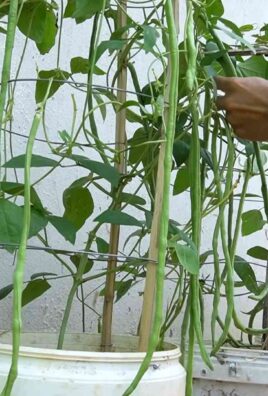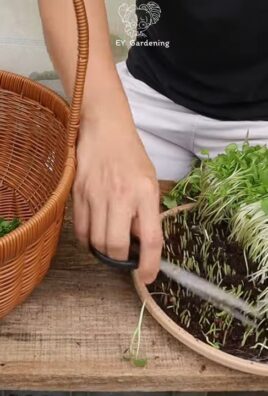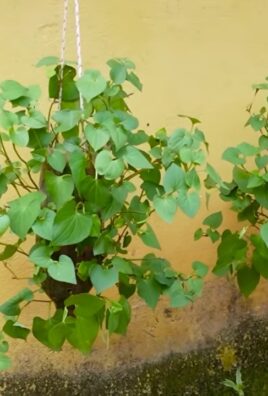Grow French Beans like a pro, even if you’re a complete beginner! Have you ever dreamed of stepping outside your back door and harvesting a basketful of crisp, delicious French beans, fresh from your own garden? It’s easier than you think, and this DIY guide is packed with simple tricks and hacks to help you achieve a bountiful harvest.
For centuries, cultivating beans has been a cornerstone of sustainable living in many cultures. From ancient civilizations relying on beans as a vital protein source to modern-day gardeners embracing their ease of growth, the humble bean has always held a special place. I think it’s time you experience that connection too!
Why should you learn these DIY tricks? Well, store-bought beans simply can’t compare to the flavor and satisfaction of homegrown produce. Plus, growing your own food is a fantastic way to save money, reduce your carbon footprint, and connect with nature. This article will give you all the tips and tricks you need to grow French Beans successfully, even if you have limited space or experience. I’m excited to share my favorite secrets with you, so let’s get started and transform your garden into a bean-growing paradise!

DIY: Growing French Beans Like a Pro (Even if You’re a Beginner!)
Okay, so you want to grow French beans? Awesome! They’re super rewarding, relatively easy to care for, and nothing beats the taste of fresh, homegrown beans. I’m going to walk you through the whole process, from choosing your beans to harvesting a bumper crop. Let’s get started!
Choosing Your French Bean Variety
First things first, you need to decide what kind of French bean you want to grow. There are two main types: bush beans and pole beans.
* Bush Beans: These are compact and don’t need support. They’re great for smaller gardens or containers. They produce a large harvest all at once, which is perfect for freezing or canning.
* Pole Beans: These are climbers and need a trellis or other support. They produce beans over a longer period, so you’ll have a steady supply throughout the season.
Within these two types, there are tons of varieties to choose from! Consider these factors:
* Color: Green is the classic, but you can also find yellow (wax beans), purple, and even speckled varieties.
* Taste: Some are sweeter, some are more earthy. Read descriptions to find one that appeals to you.
* Disease Resistance: Look for varieties that are resistant to common bean diseases in your area.
* Days to Maturity: This tells you how long it will take from planting to harvest. Choose varieties that fit your growing season.
I personally love ‘Blue Lake’ bush beans for their reliability and flavor, and ‘Kentucky Wonder’ pole beans for their prolific production. But experiment and find what works best for you!
Preparing Your Garden Bed
French beans need a sunny spot with well-drained soil. Here’s how to get your garden bed ready:
1. Choose a Location: Select a spot that gets at least 6-8 hours of direct sunlight per day.
2. Test Your Soil: A soil test will tell you the pH and nutrient levels. French beans prefer a slightly acidic to neutral pH (around 6.0-7.0). You can buy a soil test kit at most garden centers.
3. Amend the Soil: Based on your soil test results, amend the soil as needed.
* For poor drainage: Add compost, well-rotted manure, or other organic matter to improve drainage.
* For acidic soil: Add lime to raise the pH.
* For alkaline soil: Add sulfur to lower the pH.
* For nutrient deficiencies: Add a balanced fertilizer or specific nutrients as recommended by your soil test.
4. Clear the Area: Remove any weeds, rocks, or debris from the planting area.
5. Till or Dig: Loosen the soil to a depth of at least 12 inches. This will help the bean roots grow easily.
6. Rake Smooth: Rake the soil smooth to create a level planting surface.
Planting Your French Beans
Timing is key when planting French beans. They are sensitive to frost, so wait until all danger of frost has passed in your area. The soil temperature should be at least 60°F (15°C).
1. Direct Sowing: French beans are best direct sown, meaning you plant the seeds directly in the garden. They don’t transplant well.
2. Spacing:
* Bush Beans: Plant seeds 1-2 inches deep and 2-4 inches apart in rows that are 18-24 inches apart.
* Pole Beans: Plant seeds 1-2 inches deep and 4-6 inches apart at the base of your trellis or support.
3. Watering: Water the soil thoroughly after planting. Keep the soil consistently moist until the seeds germinate.
4. Germination: French bean seeds usually germinate in 5-10 days, depending on the soil temperature and moisture levels.
Building a Trellis for Pole Beans
If you’re growing pole beans, you’ll need to provide them with a trellis or other support to climb on. Here are a few options:
* Bamboo Trellis: This is a simple and inexpensive option. You can create a teepee shape by tying bamboo poles together at the top.
* Netting: Attach netting to posts or a fence to create a climbing surface.
* Wire Mesh: Use wire mesh to create a sturdy and long-lasting trellis.
* Existing Structures: You can also train pole beans to climb on a fence, arbor, or other existing structure.
No matter what type of trellis you choose, make sure it’s strong enough to support the weight of the mature bean plants. I’ve seen some pretty flimsy trellises collapse under the weight of a bean bonanza!
Caring for Your French Bean Plants
Once your bean plants are up and growing, here’s how to keep them healthy and productive:
1. Watering: Water regularly, especially during dry spells. French beans need about 1 inch of water per week. Water at the base of the plants to avoid wetting the foliage, which can lead to disease.
2. Weeding: Keep the garden bed free of weeds, which can compete with the bean plants for nutrients and water. Hand-pull weeds carefully to avoid disturbing the bean roots.
3. Fertilizing: French beans don’t need a lot of fertilizer, but you can give them a boost with a side dressing of compost or a balanced fertilizer a few weeks after planting. Avoid over-fertilizing, as this can lead to excessive foliage growth and fewer beans.
4. Pest Control: Keep an eye out for common bean pests, such as aphids, bean beetles, and spider mites.
* Aphids: Spray with a strong stream of water or insecticidal soap.
* Bean Beetles: Handpick them off the plants or use an insecticide.
* Spider Mites: Spray with insecticidal soap or neem oil.
5. Disease Control: French beans can be susceptible to diseases such as powdery mildew and bean rust.
* Powdery Mildew: Improve air circulation by spacing plants properly and pruning away crowded foliage. You can also spray with a fungicide.
* Bean Rust: Remove infected leaves and spray with a fungicide.
6. Support: For pole beans, gently guide the vines onto the trellis as they grow. They’ll eventually start climbing on their own.
Harvesting Your French Beans
The moment you’ve been waiting for! Harvesting your French beans is the most rewarding part of the process.
1. Timing: Harvest beans when they are young and tender, before the seeds inside become too large. They should be firm and snap easily when bent.
2. Frequency: Harvest beans regularly, every few days, to encourage continued production.
3. Technique: Gently snap or cut the beans from the plant, being careful not to damage the stems or leaves.
4. Storage: Freshly harvested French beans can be stored in the refrigerator for up to a week. You can also freeze or can them for longer storage.
Troubleshooting Common Problems
Even with the best care, you might encounter some problems when growing French beans. Here are a few common issues and how to address them:
* Poor Germination: Make sure the soil temperature is warm enough and the soil is consistently moist. You can also try soaking the seeds in water for a few hours before planting to improve germination.
* Yellowing Leaves: This could be a sign of nutrient deficiency, overwatering, or disease. Check the soil drainage and nutrient levels, and treat any diseases as needed.
* Lack of Flowers or Beans: This could be due to insufficient sunlight, over-fertilizing, or extreme temperatures. Make sure the plants are getting enough sunlight, avoid over-fertilizing, and provide shade during heat waves.
* Pest Infestations: Regularly inspect your plants for pests and treat them promptly.
Saving Seeds (Optional)
If you want to save seeds from your French beans to plant next year, here’s how:
1. Choose Healthy Plants: Select beans from the healthiest and most productive plants.
2. Allow Beans to Mature: Let the beans mature fully on the plant until they are dry and the pods are brown and brittle.
3. Harvest the Pods: Harvest the pods and shell out the seeds.
4. Dry the Seeds: Spread the seeds out on a tray and let them dry completely in a cool, dry place for a few weeks.
5. Store the Seeds: Store the dried seeds in an airtight container in a cool, dark place. They should remain viable for several years.
Growing French beans is a fun and rewarding experience. With a little bit of planning and care, you can enjoy a bountiful harvest

Conclusion
So, there you have it! Growing French beans at home, even if you’re short on space or time, is entirely achievable with this simple, effective DIY trick. We’ve walked you through the process, highlighting the ease and accessibility of creating your own miniature bean haven. But why is this a must-try?
Firstly, the taste. There’s simply no comparison between store-bought French beans and those you’ve nurtured yourself. The vibrant flavor and crisp texture of freshly picked beans are a culinary delight. Secondly, the satisfaction. Watching your tiny seeds sprout and flourish into a bountiful harvest is incredibly rewarding. It’s a tangible connection to nature and a reminder of the power of simple gardening. Thirdly, the cost-effectiveness. Once you’ve invested in the initial supplies, growing your own French beans becomes a significantly cheaper alternative to purchasing them regularly.
But the real magic lies in the adaptability of this DIY method. Feel free to experiment with different varieties of French beans. Consider trying climbing varieties and training them up a trellis for a visually stunning and space-saving display. You could also interplant your beans with companion plants like marigolds or nasturtiums to deter pests and attract beneficial insects. Another variation involves using different types of containers. While we’ve focused on pots, you could also repurpose old buckets, crates, or even grow bags. Just ensure they have adequate drainage.
For those looking to maximize their yield, consider succession planting. Sow a new batch of seeds every few weeks to ensure a continuous supply of fresh French beans throughout the growing season. And don’t forget to regularly harvest your beans to encourage further production. The more you pick, the more they’ll grow!
This DIY approach to growing French beans isn’t just about saving money or enjoying fresh produce; it’s about fostering a connection with nature, learning new skills, and experiencing the joy of growing your own food. It’s a project that’s suitable for gardeners of all levels, from complete beginners to seasoned pros.
We wholeheartedly encourage you to give this DIY trick a try. It’s a fun, rewarding, and delicious way to bring a little bit of the garden into your home. And once you’ve experienced the satisfaction of harvesting your own homegrown French beans, we’re confident you’ll be hooked!
Don’t be afraid to experiment, adapt, and personalize the process to suit your own needs and preferences. Gardening is all about learning and growing, both literally and figuratively.
So, grab your seeds, your soil, and your enthusiasm, and get ready to embark on your French bean growing adventure! And most importantly, we want to hear about your experiences. Share your photos, tips, and stories with us in the comments below. Let’s create a community of DIY French bean growers and inspire others to join the fun! We are eager to see how you make this DIY trick your own.
Frequently Asked Questions (FAQ)
What is the best time of year to plant French beans?
French beans are warm-season crops, so the best time to plant them is after the last frost in your area. Generally, this is in late spring or early summer. Check your local weather forecast and planting guides to determine the ideal planting time for your specific region. You can also start seeds indoors a few weeks before the last frost to get a head start on the growing season.
How much sunlight do French beans need?
French beans require at least 6-8 hours of direct sunlight per day to thrive. Choose a location that receives plenty of sunlight throughout the day. If you’re growing them indoors, place them near a sunny window or use grow lights to supplement natural light. Insufficient sunlight can lead to leggy growth and reduced yields.
What type of soil is best for growing French beans?
French beans prefer well-draining soil that is rich in organic matter. Amend your soil with compost or other organic materials before planting to improve its fertility and drainage. A slightly acidic to neutral soil pH (around 6.0-7.0) is ideal. Avoid heavy clay soils, as they can become waterlogged and hinder root growth.
How often should I water my French beans?
Water your French beans regularly, especially during hot and dry weather. Keep the soil consistently moist, but avoid overwatering, which can lead to root rot. Water deeply at the base of the plants, rather than overhead, to prevent fungal diseases. Mulching around the plants can help retain moisture in the soil.
How do I know when my French beans are ready to harvest?
French beans are typically ready to harvest about 50-60 days after planting. The pods should be firm, crisp, and snap easily when bent. Harvest them when they are still young and tender, before the beans inside become too large and tough. Regular harvesting encourages further production.
What are some common pests and diseases that affect French beans?
Common pests that can affect French beans include aphids, bean beetles, and spider mites. Diseases include powdery mildew, bean rust, and anthracnose. Regularly inspect your plants for signs of pests or diseases and take appropriate action, such as using insecticidal soap or fungicide. Good air circulation and proper watering practices can help prevent many diseases.
Can I grow French beans in containers?
Yes, French beans are well-suited for container gardening. Choose a pot that is at least 12 inches in diameter and has good drainage. Use a high-quality potting mix and provide adequate sunlight and water. Bush bean varieties are generally better suited for containers than climbing varieties, but you can still grow climbing beans in containers if you provide them with a trellis or other support.
How do I save seeds from my French beans?
To save seeds from your French beans, allow a few pods to mature fully on the plant. The pods will become dry and brown. Once the pods are completely dry, harvest them and remove the seeds. Store the seeds in a cool, dry, and dark place in an airtight container. Properly stored seeds can remain viable for several years.
What are some good companion plants for French beans?
Good companion plants for French beans include marigolds, nasturtiums, rosemary, and carrots. Marigolds and nasturtiums deter pests, while rosemary repels bean beetles. Carrots help to improve soil drainage. Avoid planting French beans near onions or garlic, as they can inhibit bean growth.
How can I improve the yield of my French bean plants?
To improve the yield of your French bean plants, ensure they receive adequate sunlight, water, and nutrients. Amend your soil with compost or other organic materials before planting. Fertilize your plants regularly with a balanced fertilizer. Regularly harvest your beans to encourage further production. Consider succession planting to ensure a continuous supply of fresh beans throughout the growing season. Also, make sure to provide support for climbing varieties to maximize space and yield.




Leave a Comment